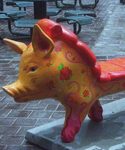 During the early 19th century, the steam-driven riverboat became the primary mode of inland shipping and transportation along the Ohio and Mississippi River valleys. There were pork-packing houses all across the Ohio River, but the center of the hog trade was Cincinnati, where the steamboats docked at its Port. By the 1840s, the city was already nicknamed "Porkopolis." By mid-century, however, the railroads began taking over the American midsection. The cattle and hog industries made better time, therefore better money, with this new mode of travel. With a major rail hub in the city of Chicago, the bulk of the stockyards made their way due northwest, and with the demise of the steamboat, Chicago remains to this day the major urban stockyard center.
During the early 19th century, the steam-driven riverboat became the primary mode of inland shipping and transportation along the Ohio and Mississippi River valleys. There were pork-packing houses all across the Ohio River, but the center of the hog trade was Cincinnati, where the steamboats docked at its Port. By the 1840s, the city was already nicknamed "Porkopolis." By mid-century, however, the railroads began taking over the American midsection. The cattle and hog industries made better time, therefore better money, with this new mode of travel. With a major rail hub in the city of Chicago, the bulk of the stockyards made their way due northwest, and with the demise of the steamboat, Chicago remains to this day the major urban stockyard center.Having been relieved of the smell and the filth associated with that industry, Cincinnatians were quick to leave this piece of their history behind. Then in 1988, to coincide with the city's bicentennial, Andrew Liecester was commissioned to create sculptures for a new park at the riverfront. His gateway design featured winged pigs on top of simulated steamboat stacks. After initially mixed reviews, the city began to embrace its rediscovered icon. In recent years, a collection of over 400 pig sculptures were displayed as part of the Big Pig Gig. Then there is The Cincinnati Dancing Pigs, a local jug band of five guys who, in forty years, never managed to grow up.


